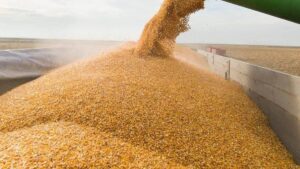
The U.S. Department of Agriculture (USDA) raised the forecast of wheat exports from Ukraine in 2023/24 marketing year by another 1.5 mln tonnes to 16.5 mln tonnes.
According to the April report of the U.S. agency, at the same time, the estimate of carry-over stocks at the end of the MY was reduced from 3.28 mln tonnes to 1.58 mln tonnes, domestic consumption – from 7.7 mln tonnes to 7.3 mln tonnes, and carry-over stocks at the beginning of the MY – from 3.5 mln tonnes to 2.9 mln tonnes.
As for Ukrainian corn, the forecast of its exports after increasing by 1.5 mln tons in March, in April was kept at the same level – 24.5 mln tons.
At the same time, the overall forecast for Ukrainian feed grains was increased by 0.1 mln tonnes to 26.97 mln tonnes due to the same reduction of carry-over stocks at the end of this MY to 4.08 mln tonnes.
In general, the updated global wheat harvest forecast for 2023/24 MY has been improved by 0.66 mln tonnes to 787.36 mln tonnes, while the forecast for global wheat exports has been increased by 1.34 mln tonnes to 213.47 mln tonnes. On the contrary, experts revised the forecast of wheat ending stocks in the world downward by 0.56 million tons to 258.27 million tons.
As for corn, the forecast for its global production in April was reduced by 2.38 million tons to 1 billion 227.86 million tons, while exports were reduced by only 0.47 million tons to 200.59 million tons. The USDA also lowered its estimate of carryover stocks by 2.35 million tons to 318.28 million tons.
As reported earlier, Ukraine attributed the improvement in grain export estimates for this marketing year to the increase in the volume of grain transportation through the new sea corridor under the control of the Ukrainian Navy.

In January-March 2024, Ukrzaliznytsia JSC (UZ) increased export transportation to ports by 2.4 times compared to the same period in 2023 – up to 15.347 million tons, while reducing the volume of transportation through land crossings in export traffic by 11.9% to 8.041 million tons, according to an analytical note of the company following the meeting of the Exporters’ Office.
In total, Ukrzaliznytsia transported 44.69 million tons of cargo in the first quarter of this year, which is 28.7% more than in the first quarter of 2023. Export transportation accounted for 52.3%, or 23.9 million tons, up 50.6% year-on-year.
In January-March, the company’s export transportation volume of iron and manganese ore increased 2.4 times year-on-year to 9.89 million tons, grain cargo – by 18.4% to 9.9 million tons, and ferrous metals – by 13% to 1.19 million tons.
In addition, the volume of vegetable oil transportation in export traffic in January-March increased by 7.5% to 424.2 thousand tons, construction materials – by 1.8 times to 545 thousand tons, cement – by 49.2% to 277.8 thousand tons.
Earlier, Oleksandr Kubrakov, Vice Prime Minister for the Reconstruction of Ukraine, Minister of Community Development, Territories and Infrastructure (Ministry of Reconstruction), said that in March 2024, Ukrzaliznytsia transported 16 million tons of cargo in all directions, which is a third more than in March 2023 and 10% more than the record figures for February 2024, when the volume of traffic reached 14.5 million tons.

“Kernel, one of Ukraine’s largest agricultural groups, has purchased a third vessel for grain exports with a carrying capacity of more than 50,000 tons, the agricultural holding’s press service reports on Facebook.
“We have purchased a new vessel Rotterdam Pearl V, capable of exporting more than 50 thousand tons of grain. Now our fleet already includes three vessels that can export about 100 thousand tons of grain and 20 thousand tons of sunflower oil per month,” the statement said.
The company added that it continues to invest in expanding maritime logistics capabilities for the Ukrainian agricultural industry.
“Our own fleet has been providing Ukrainian exports to the Mediterranean and North-East Atlantic countries for more than a year and allows us to manage costs along the entire logistics chain. The development of our own shipping, in particular, does not force us to fix tonnage from the market, which is unprofitable during the period of inflated freight rates during martial law,” the statement said.
Before the war, Kernel Agro Holding was the world’s leading producer of sunflower oil (about 7% of global production) and its exports (about 12%). It is one of the largest producers and sellers of bottled oil in Ukraine. In addition, it is engaged in the cultivation and sale of agricultural products.
Kernel’s net profit for FY2023 amounted to $299 million, while the company ended the previous year with a net loss of $41 million. The agricultural holding’s revenue for FY2023 decreased by 35% to $3.455 billion, but EBITDA increased 2.5 times to $544 million.

The USAID Rural and Agricultural Development Program has announced the launch of a program to co-finance 20 Ukrainian agricultural processing enterprises that intend to restore and develop their export potential, the press service of the Ministry of Agrarian Policy and Food reports.
According to the report, the competition is open to non-state (private) enterprises/companies that have export-oriented development strategies and are regular exporters.
The companies can receive co-financing to increase the volume of purchases and processing of raw materials, in particular, by attracting micro, small and medium-sized agricultural producers for long-term partnership. Grant recipients will also be able to introduce new grain processing technologies to increase productivity by at least 25%.
It is expected that with the grant funds, the companies will be able to develop a long-term export strategy and increase sales by 20% through 5 new export channels and markets for processed products and increase sales in foreign markets.
The USAID AGRO program will focus on restoring and strengthening processing capacities to produce value-added products for export, such as corn for feed and food; wheat for food, industrial and feed purposes; rye for industrial and feed purposes; industrial sunflower seeds; high oleic sunflower seeds; soybeans for industrial and feed purposes; varietal and regular cycle seeds.
The donor organization has drawn the attention of applicants to the fact that projects aimed at storing grains, oilseeds and pulses, including receiving, cleaning, drying, storing, and shipping grain by rail and road, are not eligible.
The application deadline is May 31, 2024.

In 2023, Agrotrade agricultural holding exported grain to 13 countries, with Egypt and Tunisia being the largest buyers, the company’s press service reported on Facebook.
According to the report, Egypt, Tunisia, Turkey, and Spain were the largest buyers of grain from Agrotrade. Grain was also supplied to Italy, Vietnam, Greece, Hungary, Romania, Latvia, Cyprus, Bulgaria, and Austria.
“Last year, we worked mainly with our usual destination countries, except for Tunisia, to which we exported large batches of corn for the first time – almost 56 thsd tonnes. Thus, this country immediately took the second place in the structure of our foreign trade. In general, Egypt purchased the largest volumes of grain from the company – over 35 thsd tonnes of corn and over 25 thsd tonnes of soybeans. Traditionally, we supplied large volumes of agricultural products to Turkey and Spain. Our southern neighbors bought soybeans and corn, while the Spaniards bought wheat. The smallest volumes of goods went to Austria – 320 tons of soybeans,” said Andriy But, Director of the agroholding’s Foreign Economic Activity Department.
As reported, in 2023, Agrotrade supplied about 350 thsd tonnes of grain to the global market. The share of own agricultural products amounted to 35% or 116 thsd tonnes, and third-party producers – 65% or 230 thsd tonnes.
The Agrotrade Group is a vertically integrated holding company with a full agro-industrial cycle (production, processing, storage and trade of agricultural products). It cultivates over 70 thousand hectares of land in Chernihiv, Sumy, Poltava and Kharkiv regions. Its main crops are sunflower, corn, winter wheat, soybeans and rapeseed. It has its own network of elevators with a simultaneous storage capacity of 570 thousand tons.
The group also produces hybrid seeds of corn and sunflower, barley, and winter wheat. In 2014, a seed plant with a capacity of 20 thousand tons of seeds per year was built on the basis of Kolos seed farm (Kharkiv region). In 2018, Agrotrade launched its own brand Agroseeds on the market.
Vsevolod Kozhemiako is the founder and CEO of Agrotrade.